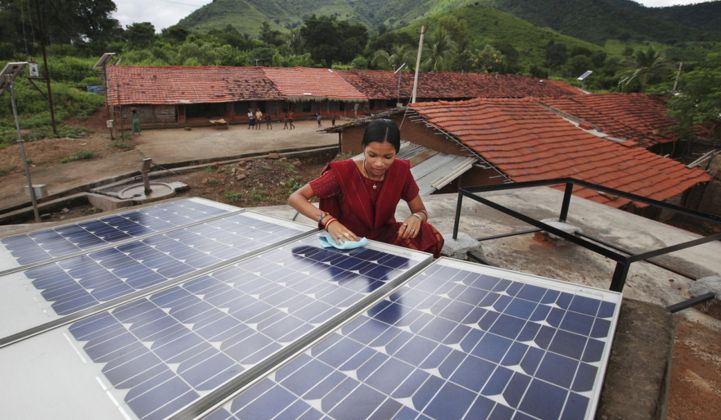Analysts are praising a new policy framework being drafted to support solar microgrids for rural electrification in India.
“The policy provides some much-needed certainty to the sector and includes measures such as single-window clearance, grid connectivity and pricing visibility for evolution of bankable business models,” wrote Bridge to India in a blog post earlier this month.
The Indian Ministry of New and Renewable Energy’s draft national policy for minigrids and microgrids aims to create up to 500 megawatts of capacity over the next five years. It follows past challenges in getting the sector off the ground.
“India has a terrible record on providing reliable grid electricity to large parts of the country,” wrote Bridge to India. “Several startups have enjoyed limited success...but a scalable, profitable model seems to be elusive.”
The solar analyst firm said the policy would address current challenges by, for example, regulating prices for minigrid projects, streamlining regulatory approvals and clarifying where grid extensions are not planned.
Other helpful measures include creating local committees for payment collection and dispute resolution, supporting grid connections to sell power to local utilities, and specifying quality and performance standards.
The policy is expected to benefit states where electrification rates are low, such as Uttar Pradesh, Bihar and Odisha, said Jasmeet Khurana, a representative of Bridge to India, in an interview.
“The targets for the policy are fairly small in terms of megawatts to be added,” he said. “The real impact will be on rural electrification, especially in areas where there is a private-sector focus on microgrid-based electrification.”
Even so, regulators may face a challenge in pushing the changes through quickly enough to meet Prime Minister Narendra Modi’s target of providing round-the-clock power for all Indians by 2019. “The policy is currently in the draft stage,” cautioned Khurana.
“Based on public comments, it will be modified and enter the ratification process. Once ratified, individual state governments would also announce their policies and processes for on-ground implementation," he said. Thus, the implementation time will vary across different states. It could be up to a year before implementation is finalized.
Meanwhile, India is in the midst of a major program to connect 250 million people without access to the grid, along with others throughout the country who face power shortages.
India’s US$11 billion rural electrification program, called Deen Dayal Upadhyaya Gram Jyoti Yojna, includes a target of delivering power to 18,452 villages by 2018. Of these, 14,204 can be served by grid extensions, and the remaining 3,449 need off-grid power.
While work on grid extensions is proceeding ahead of schedule, with 51 percent of villages already connected, only 20 percent of the off-grid target has been achieved so far, according to government figures.
Earlier this month, Indian off-grid solar power benefited from a U.S.-India agreement expected to bring in up to US$1 billion in investment. Bridge to India gave the news a cautious welcome on account of the challenges involved in securing investment for small-scale off-grid projects.
Those looking to bring power to other developing countries will be watching India’s rural electrification rush closely. Many are debating whether it makes sense to extend the centralized grid or to support off-grid systems and islanded microgrids.
The distributed energy advocacy group Power for All, for example, worries that grid extensions will not occur quickly or cost-effectively enough to meet the United Nations' millennium goal of eradicating energy poverty by 2030.
“The business-as-usual approach would be too expensive, take too long and not be sustainable,” said William Brent, Power for All’s director of communications. “We started out with the premise that speed was a key value proposition for decentralized renewable energy.”
India will be an important case study in the rush to electrification. “Even though the government has a plan to connect everyone, it will not be an easy task and will take time,” said Khurana.



